

It’s that time of year again – the countdown to the annual Build It Awards ceremony on 8th November is on. In the run-up to the event, our editorial team and the Awards judges have pored over all the readers’ homes showcased in the magazine over the last year. We’ve whittled them down to just six contenders, which are now in with a chance of winning Build It’s Best Self Build or Renovation Project 2024.
From charming timber and oak self builds to unrecognisable renovations and sensitive period restorations, this year’s homes highlight what’s possible when you set your mind to the task of developing a bespoke house. Our selection includes dwellings that are finished to a broad spectrum of budgets, designs and styles, cherry picked from all over the country. What they have in common is the vision, ambition and hard work required by the homeowners who created them. Though each project is worthy of taking the top prize, there can only be one victor – so we need your help to decide which property comes out on top.
The winner is chosen 100% by you, our readers. This page provides a snapshot of what went into each of the projects, highlighting their standout triumphs. For more detail, click the buttons underneath each project to read their full stories and take a deep dive into the ins and outs of every scheme.
Voting is now closed. The winner will be announced at the Build It Awards ceremony on the 8th November 2024.
In search of a property that was in closer reach of city life, couple Mark Camillin and Liam Denny looked at a village in Hampshire only one hour from London by train. They quickly found a four-bed grade II listed house built in the 1780s. It had been extended and refurbished multiple times, resulting in a collection of small dark rooms on different levels.
Mark and Liam weren’t set on the house immediately, but once they saw the views from the garden and its beautiful orchard, they were sold. So, they decided to undertake a renovation of the property to bring its energy performance up to modern-day standards and add an extension to make sense of the jumbled layout.
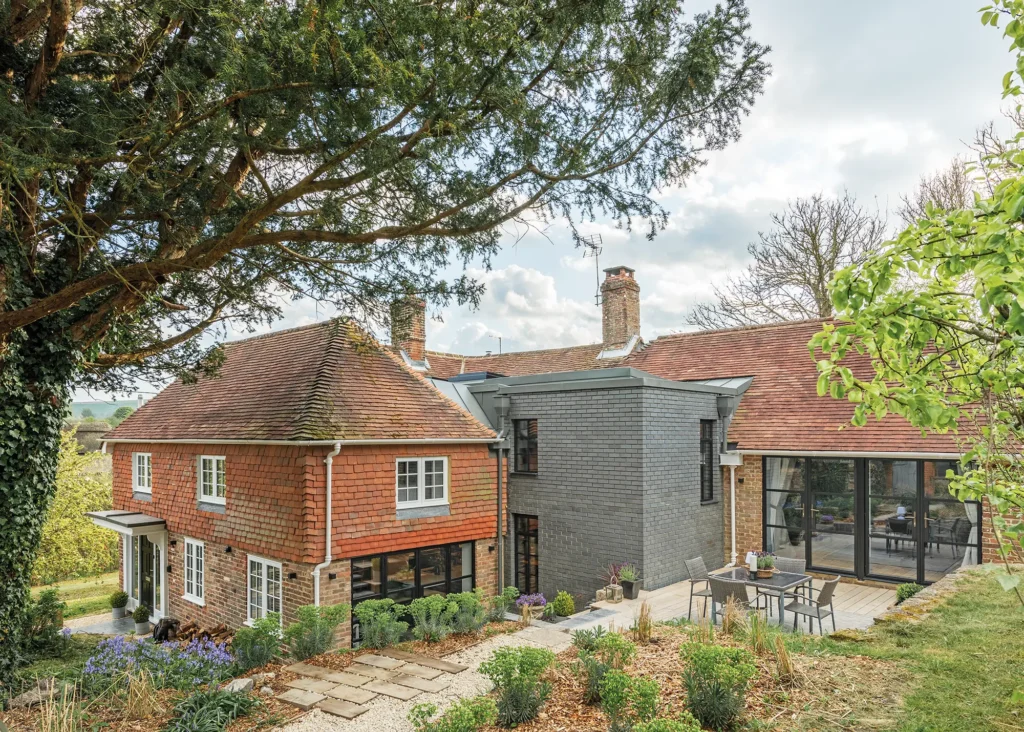
Photo: Richard Downer
The architect couple, who run Camillin Denny Design, knew how to go about their research to maximise their chances of getting planning. When Mark and Liam bought the property, the plan had a middle room and a snug that formed the original house. In between these rooms, a staircase – which they discovered was added in the 1950s – led up to the bedrooms. On the ground floor, there were steps up into a living room extension, which was built in 1989.
The solution was to knock through the utility, boot room and WC to create a new open-plan kitchen and dining area. The staircase was relocated to a new double-height extension. The first flight connects the living room and the second the bedrooms and bathrooms.
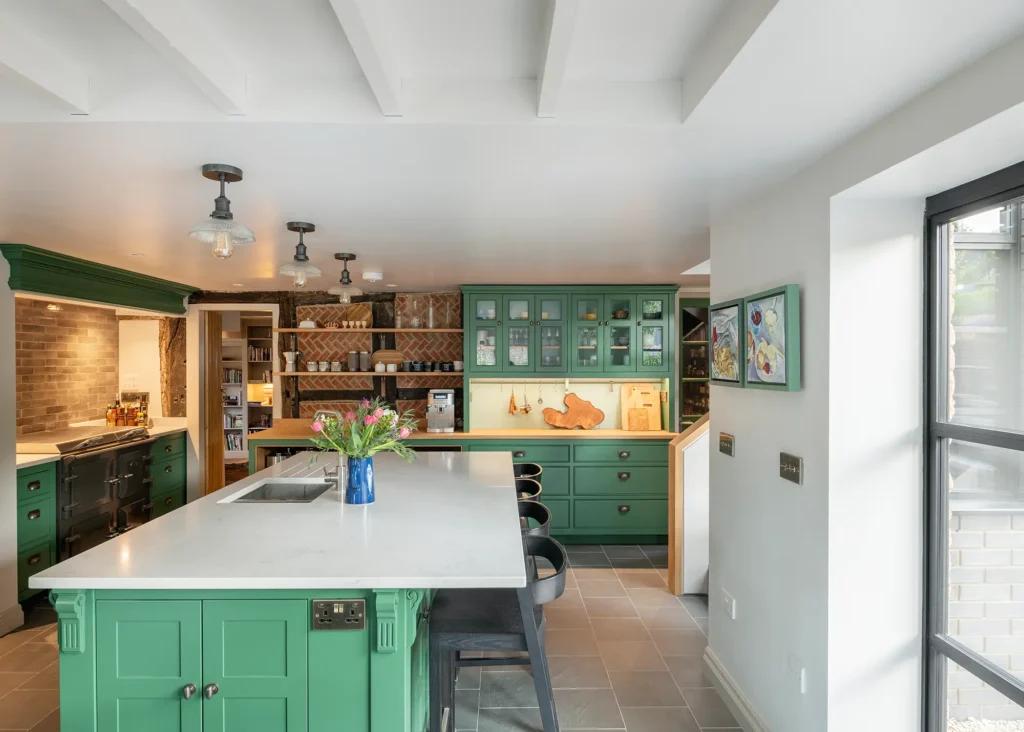
Photo: Richard Downer
Mark and Liam carried on tweaking the drawings over a two-year period until they’d resolved all the problems. Most of their proposed changes were to the1980s extension and not to the heritage fabric, and they wouldn’t be visible from the front. This worked in their favour when securing planning permission in just four months.
The single glazing and insulation were replaced and enhanced in line with heritage restrictions, and an air source heat pump, underfloor heating and solar panels were installed. The overall fuel bill came down from £4,000 per year in 2019 to just over £150 in 2022. “It’s unbelievable to think we live in a listed house built in the 1780s, yet in 2023 we’re totally fossil fuel-free in a property with a B energy rating,” says Mark. “This is the first time we’ve bought a house that we didn’t initially love and it’s turned out to be our best project.”
| OWNERS | Mark Camillin & Liam Denny |
| PROJECT | Renovation & extension |
| LOCATION | Hampshire |
| SIZE | 381m² (incl garage & annexe) |
| PROJECT COST | £500,000 |
| COST PER M² | £1,312 |
Susan and John Shearer’s holiday home in Cairngorms National Park wound up being the perfect plot to self build, thanks to its peaceful location at the edge of the forest. The couple decided they would knock down the existing one-bed timber cottage with its tin roof, which they bought back in 1992, and replace it with their full-time dream home.
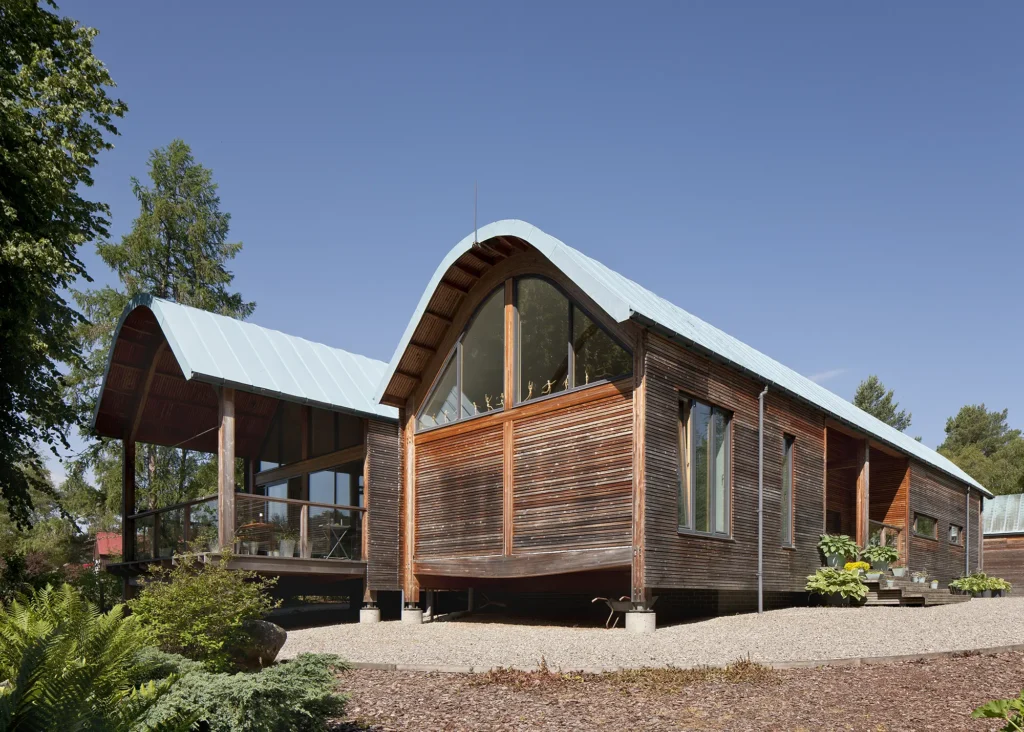
Photo: David Barbour
Inspired by one of his award-winning projects, Susan and John reached out to architect Gokay Deveci to design their scheme. The replacement build would have to be considerably larger than the original to meet their needs and, because of its sensitive location, the amibitious project underwent a two-year long planning process.
Gokay reassured the council that the scheme would be contextual and cause minimal disturbance to the surrounding nature. Eventually, the proposal was passed on the basis it was an exemplar of quality design and sustainable architecture. The single-storey home features two wings, each with a curved roof structure. One volume contains the living, kitchen and dining area, while the bedrooms and bathrooms are located in the other. The roof extends out to canopy three terraced zones, which are shaded by a lime tree.
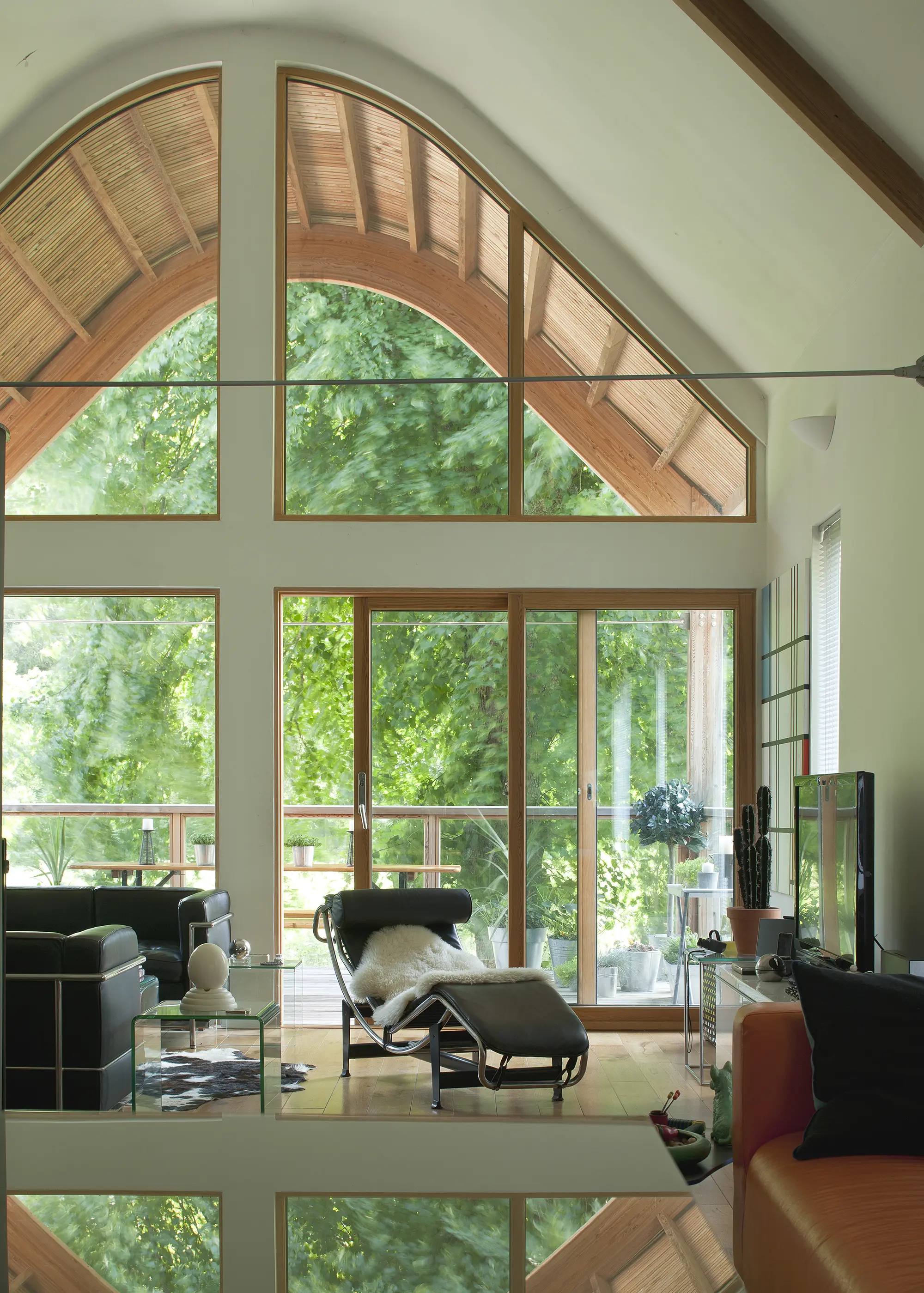
Photo: David Barbour
The laminated post and beam and timber frame wall panels were manufactured offsite. “We couldn’t get a specialist in Scotland to make the roof curve. So, I found a Norwegian engineer who designed a solution with 12mm sections of larch glued together to achieve the unique shape,” says Gokay. The structure was lifted off the ground and placed on concrete pad foundations in order to protect and minimise the impact on the woodland.
Extra insulation was added on site to the timber panels to meet the highest energy standards. The house can’t rely on passive solar gain due to the shade cast by the surrounding trees, but the insulation, triple glazing and underfloor heating laid within a 50mm concrete screed in the suspended timber floor result in a super energy-efficient build that keeps warm and cosy. “I look up at the house and still think it’s just amazing,” says Susan. “When the odd cyclist or walker comes past, you can see how impressed they are.”
| OWNERS | Susan & John Shearer |
| PROJECT | Self build |
| LOCATION | Inverness-shire |
| SIZE | 290m² (incl studio & garage) |
| PROJECT COST | £645,000 |
| COST PER M² | £2,224 |
Stephen and Ann Smith’s barn-style self build in the Cotswolds replaces three metal lockups that sat alongside a barn and stable. Situated in an area of outstanding natural beauty (AONB), the plot was marketed with permission to build a small, 170m² house, but the couple were looking for something bigger that could host their extended family. They reached out to Abberley Design, which was behind the original plans, to increase the floor plan to 230m².
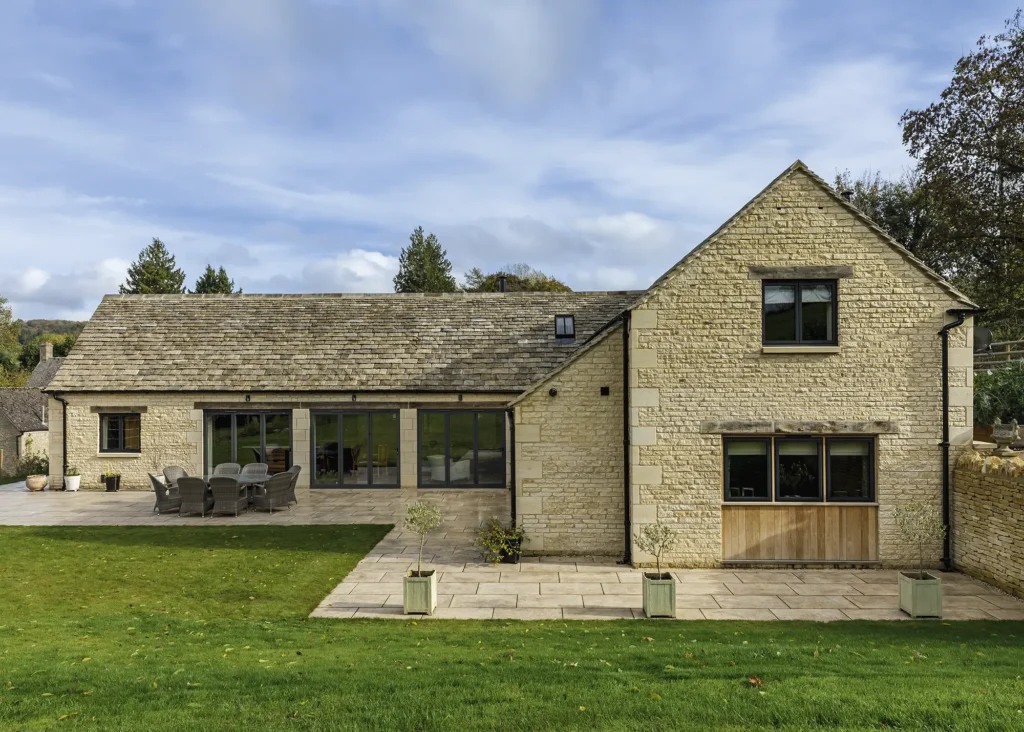
Photo: Simon Maxwell
However, its location meant there were tight planning restrictions – one of which concerned the height of the building. To meet this requirement, the existing design was a one-and-a-half-storey house with a single bedroom on the upper floor. Stephen and Ann wanted four bedrooms, making it closer to a two-storey house. So, the designer’s solution was to excavate over 800 tonnes of soil to lower the foundations, which required a lot of tanking to preclude any damp issues. The extra space allowed for three bedrooms on the upper storey and a fourth on the lower ground floor, where a lightwell compensates for the limited number of windows – another planning restriction.
The protected site also meant that the house had to resemble an old agricultural barn from the exterior, using contextual materials. To accommodate this, the structure is made from Cotswold stone using cavity wall construction.
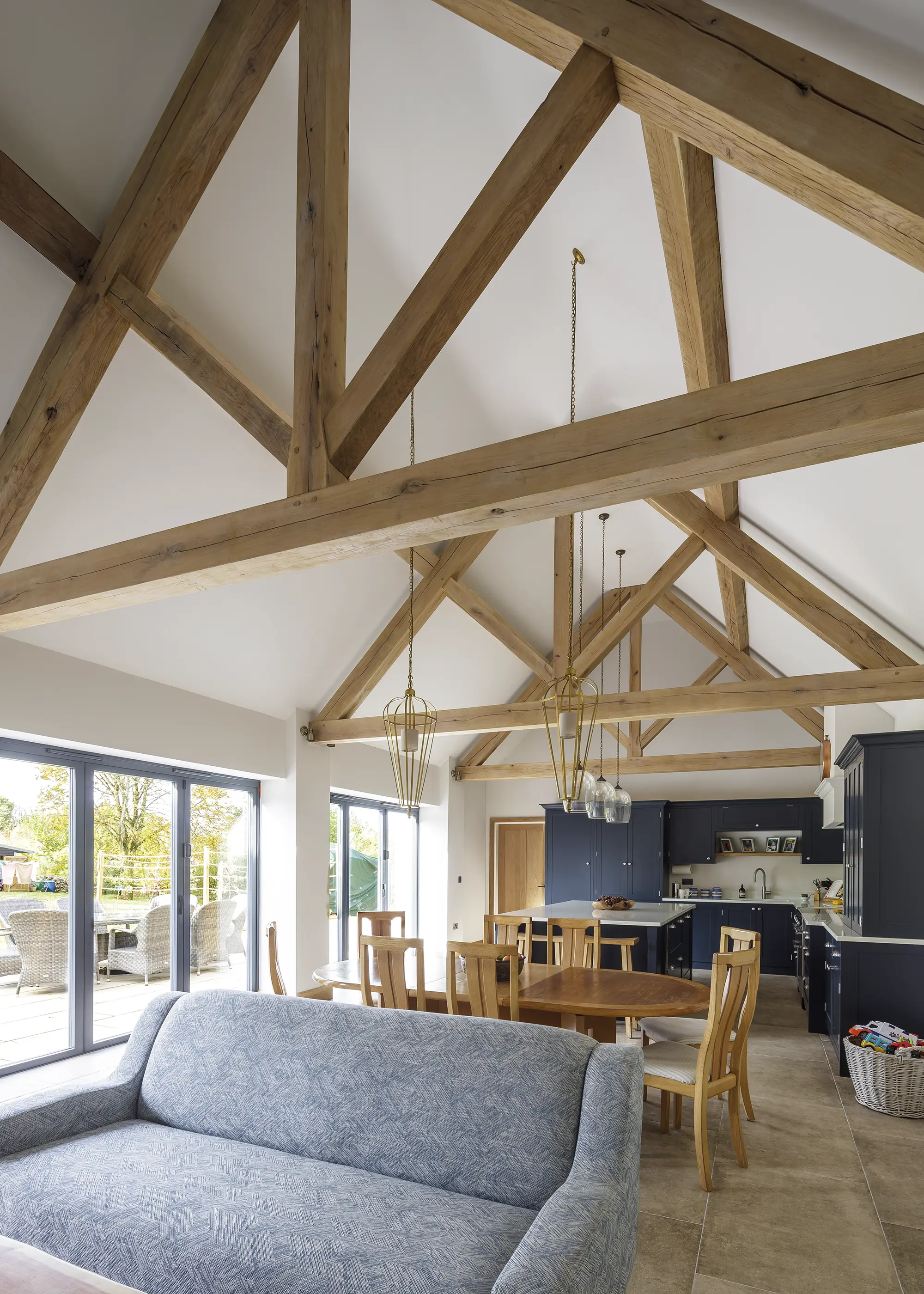
Photo: Simon Maxwell
Due to the backlogs from the pandemic, it was 10 months before Stephen and Ann secured consent. Construction began with preparing the lower-ground floor, and Stephen was lucky enough to find a farmer who wanted to use the 50 trailer-loads of soil they excavated, saving them a huge amount of money in disposal.
The couple also opted for a ground source heat pump, for which they obtained a government grant. This required drilling three 90m-deep holes and took three weeks instead of the intended five days due to the stony Cotswold brash and thick layers of clay – but it was ultimately worth it for the heat pump’s excellent performance. “It’s been a very rewarding,” says Stephen. “The design blends so perfectly into the beautiful Cotswold landscape.”
| OWNERS | Stephen & Ann Smith |
| PROJECT | Self build |
| LOCATION | Gloucestershire |
| SIZ | 230m² |
| PROJECT COST | £800,000 |
| COST PER M² | £3,478 |
John and Melanie Stott searched for some time for the perfect long-term home in Edinburgh for their young family. They eventually found it in the form of a three-storey, six-bed late Victorian terraced house – it had a garden and was just a short walk from the city centre. The property had been well loved, but not updated in several decades, so they knew they would need to undertake a renovation to make it fit for family life.
Before buying, the couple spoke to architect Sean Gaule, who reassured them that there was plenty of scope to create the open-plan, energy-efficient home they sought. The Stotts lived in the property for around a year before work began, giving them a good idea of what worked for them and what didn’t.
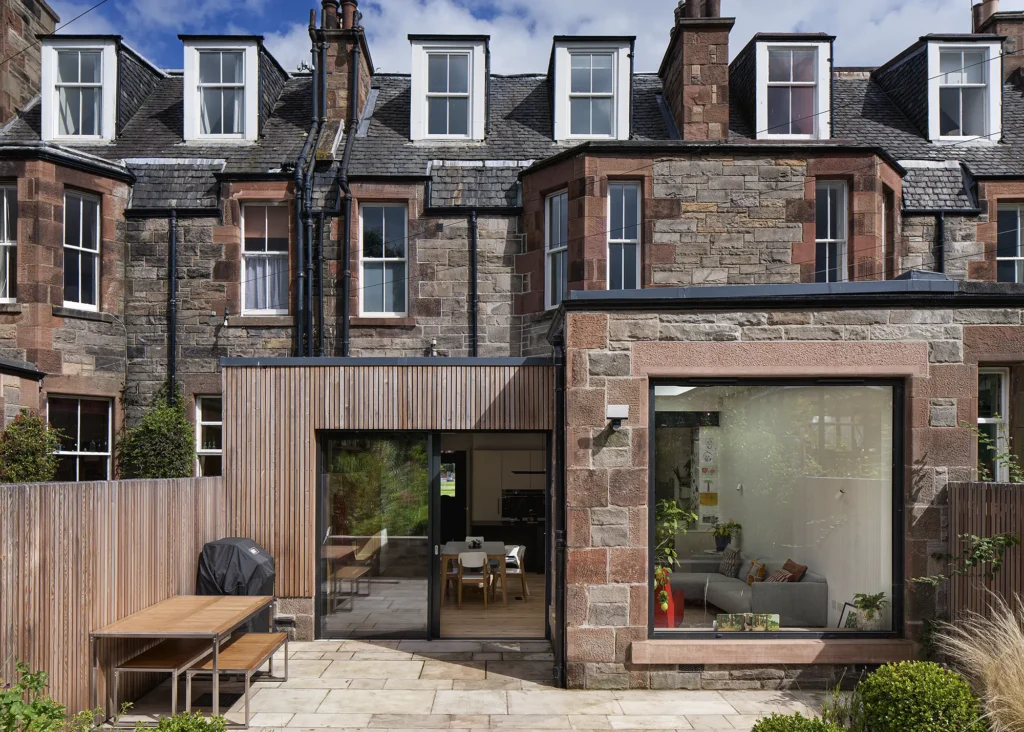
Photo: David Barbour
The final scheme added 20m² of space to the back of the house by replacing an existing stone annexe and connecting it to the house. The stone from the existing structure was carefully removed and reused so that it resembles the original annexe, except better insulated and waterproofed.
The new adjoining extension is constructed from timber frame with wood cladding, softening the contrast between old and modern. Its roofline is lower than the stone volume to minimise overshadowing of the neighbours’ property. The extension also had to be built on raft footings, since those of the original house were unusually deep, reaching 1.5m. Going to the same depth would have had major cost implications, though accommodating these changes only lost John and Melanie a week in the schedule in the overall schedule.
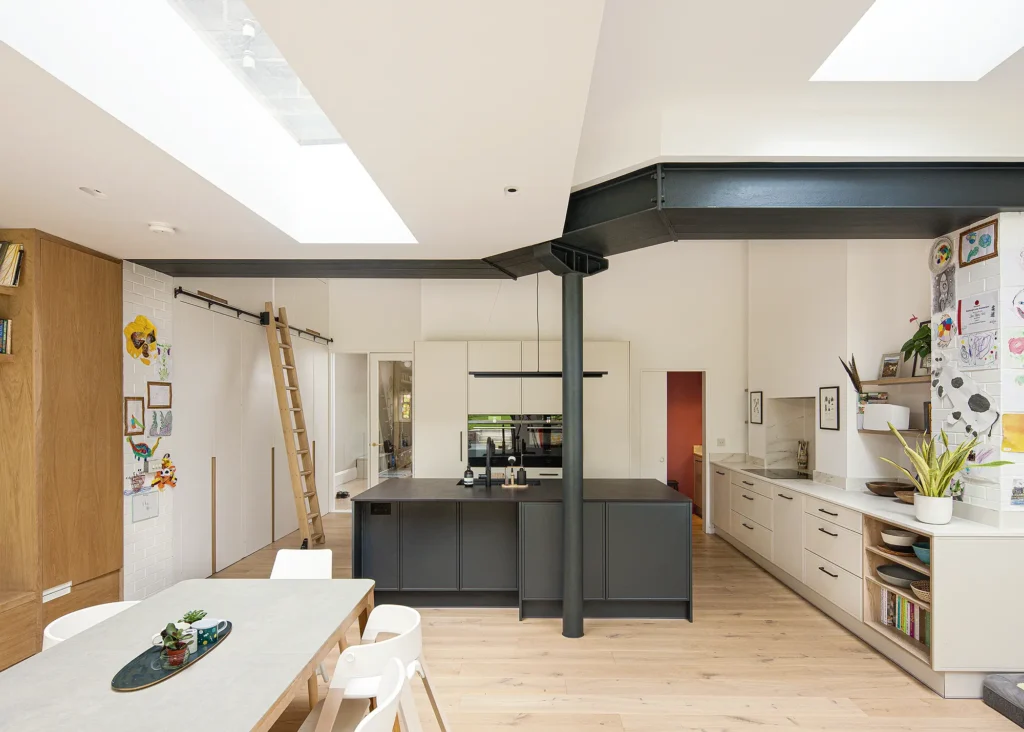
Photo: David Barbour
The steel support beams and central column became key design features. The top of the pillar has a bespoke crown that takes multiple beams into it, engineered to carry the building structure. In addition, the electrics in the existing property were upgraded and floors insulated to improve energy efficiency. The single-glazed windows were all replaced with double-glazed sash and casement units, which are fully draughtproofed.
The couple decided against insulating the walls to avoid the risk of losing any original features, such as the cornicing. “Being a late Victorian house, the ceilings are really high, but this adds to its unique charm and it’s a really comfortable environment despite this,” says Jonathan. “The biggest change, and the thing that we most enjoy, is the light at the back in the open-plan room,” he adds. “I didn’t expect such a big window at the rear but it works beautifully. It’s a lovely space; the amount and quality of light is fantastic.”
| OWNERS | John & Melanie Stott |
| PROJECT | Renovation & extension |
| LOCATION | Edinburgh |
| SIZE | 257m² (incl.20m² extension |
| PROJECT COST | £320,000 |
| COST PER M² | £1,245 |
Chris and Mary Noon replaced a 1950s prefabricated bungalow in Dorset with their beautiful oak frame self build. The site, which offers incredible views of the coast, already had planning permission to build a new home on the footprint of the existing build.
After doing lots of research and visiting various show homes, Chris and Mary fell in love with oak and its inherent character, choosing Westwind Oak to supply and install the oak frame and structural insulated panel (SIP) envelope. “The reason we liked Westwind was because they do a lot of their work by hand and shaping the beams to the natural curves of the wood,” says Chris.
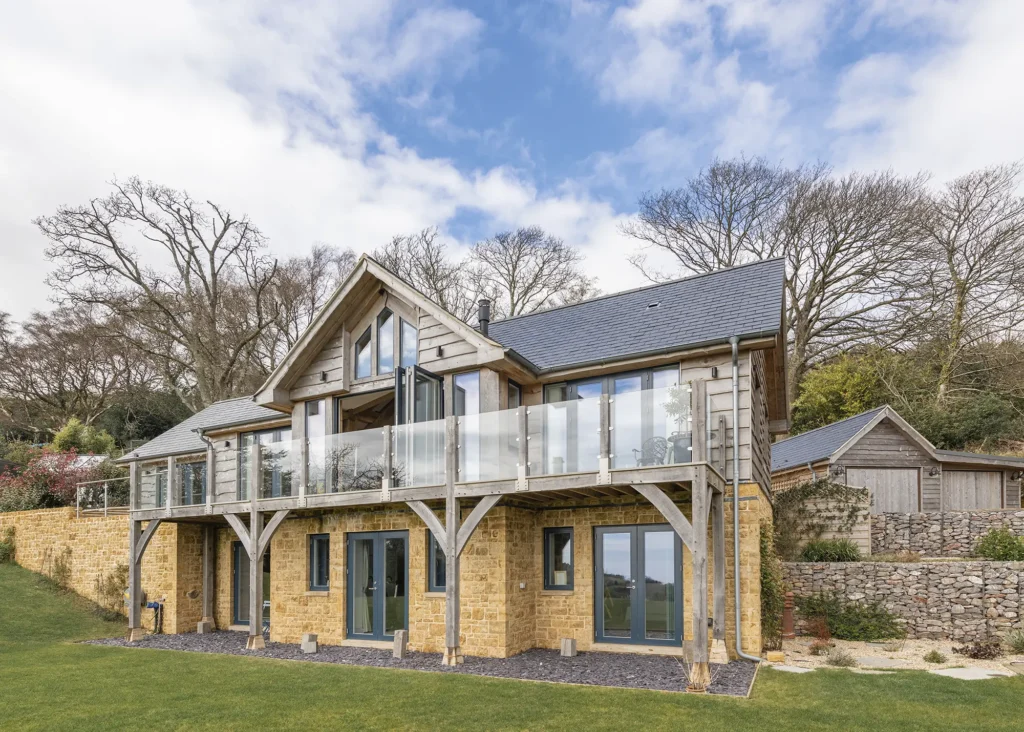
Photo: Richard Downer
The couple also enlisted the help of Nick Wordie at Roderick James Architects, who had plenty of experience working with the unique characteristics of oak. The structure of their home was detailed so the plasterboard sits outside of it. “As the oak dries out, the shrinkage cracks are hidden behind the frame, rather than being exposed and requiring future filling,” says Nick. “If it was abutted to the oak, you would get cracks from shrinkage.”
One of the main challenges of the build was the steeply sloping plot. Nick’s solution required digging in major retaining walls to hold back the hill and trees. The proposed scheme consisted of a two-storey, upside-down layout to make the most out of the views. All the key living spaces were placed on one floor to futureproof the home.
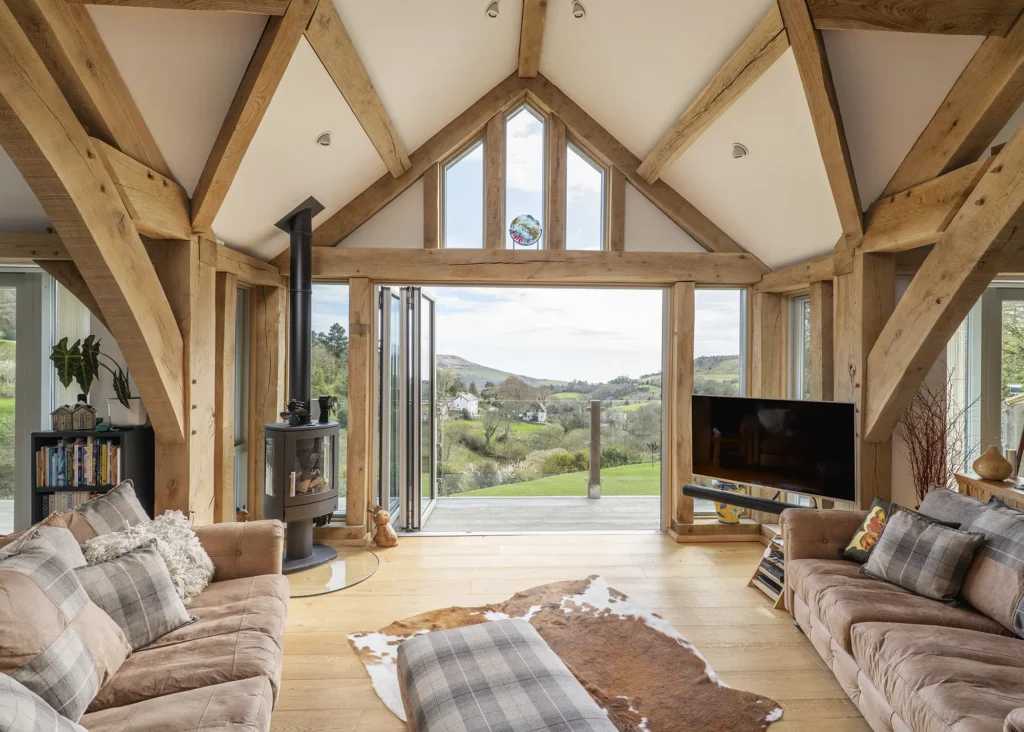
Photo: Richard Downer
However, the existing planning consent was for a single-storey house, so the new design faced significant opposition from the local authority. Chris and Mary compromised by removing upper floor from their detached garage design and lowering the pitch of the roof on the main house. Nick worked closely with the case officer and, after several months, the new design was eventually approved.
Having project managed many extensions before, Chris and Mary were confident about overseeing the build themselves. The plot sits on a green sand foundation, so the Noons put in a thick concrete raft foundation to support their home.
The oak structure was erected in just three days and the SIPs envelope in a further five. “It was so exciting to see – it went up so quickly we thought we would be moving in soon,” say Chris and Mary, who have zero regrets when looking back on their build journey. “I’d recommend self building to anyone,” adds Chris. “Though I wouldn’t do it again, as what we’ve created is so fantastic.”
| OWNERS | Chris & Mary Noon |
| PROJECT | Self build |
| LOCATION | Dorset |
| SIZE | 176m² |
| PROJECT COST | £662,500 |
| COST PER M² | £3,764 |
Experienced renovators, Lucas Pulak and Agnieszka Zala were confident they could transform a 1960s detached house in Bromley with a 1,000m² plot into their dream home. The two-storey property, which had three bedrooms, was liveable but was significantly dated. A builder by trade, Lucas considered knocking it down and starting from scratch, but ultimately decided to undertake a major renovation and extension.
The couple teamed up with architects, Matthew and David Design, interior designer, Studio 152, and landscape gardener, James Lee, to plan their home and garden. “Our jobs don’t allow us to travel during summer,” says Agnieszka. “So, we wanted to a place where we could enjoy our summers and feel like we’re abroad.”
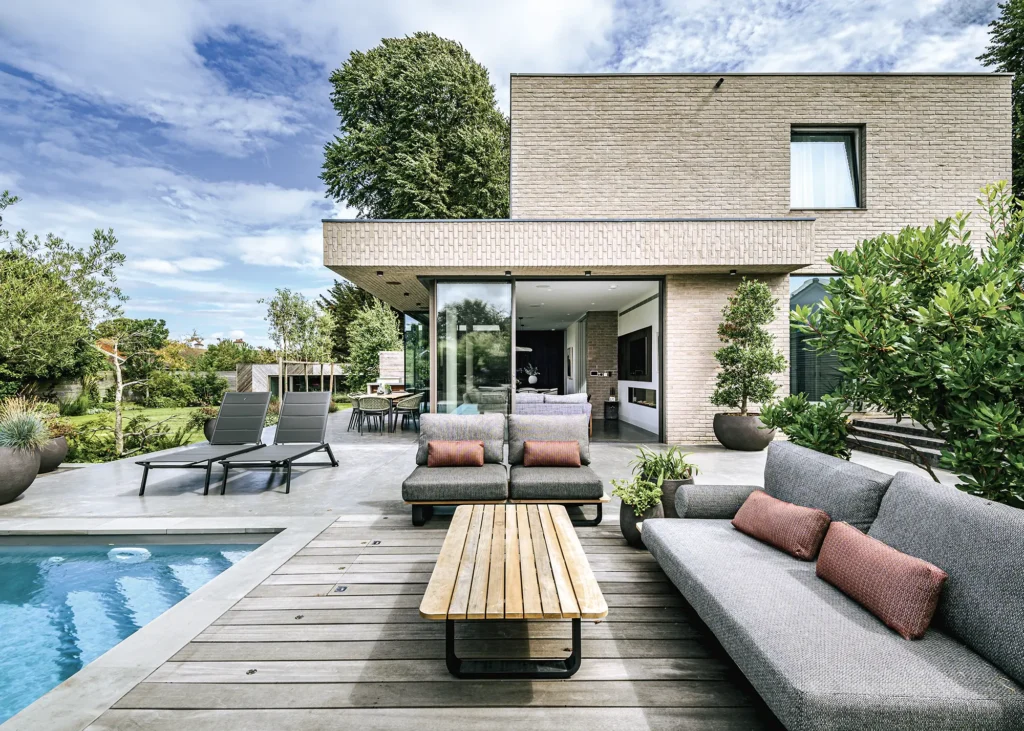
Photo: TradePhotographer.com
Permission to build the gym and sauna, which were to be located in a new outbuilding, was allowed under permitted development. But consent for the epic renovation and extension works was an incredibly challenging process, involving several rejections. Seriously close to sellin up, Lucas and Agnieszka gave it one final go.
They were assigned a new case officer, who advised using a brick finish and reducing the scale of the house to be in keeping with the neighbouring properties. After two years of back and forth, the couple finally secured permission for their home, featuring four bedrooms, an open-plan kitchen, dining and living area that leads out onto the garden and swimming pool.

Photo: TradePhotographer.com
Lucas took on project management duties, overseeing the entire process. He and the team at Lucas Pulak Construction removed almost all of the main build’s existing walls, retaining only the facade and a side wall, which were wrapped in insulation. Strip foundations were laid before the new elements of the house were constructed from cavity block walls, finished with brick slips.
Lucas had planned ahead and pre-ordered a lot of the raw building materials to store on site, which helped alleviate the impact material delays and inflation would have on the project. “Financially, we were prepared for a big build, and any unforeseen expenses, but after costs increased, we were lucky to able to finish the house,” he says.
Despite a few stressful setbacks, the couple love their new home. “As soon as the work was done and we could sit outside with a glass of wine, we knew it was worth it,” says Agnieszka. “We love the house and spend a lot of time in the garden.” Their neighbours approve of the transformation, too. “We’ve changed the look of this tired part of the street and people often tell us how nice it is,” says Lucas.
| OWNERS | Lucas Pulak & Agnieska Zala |
| PROJECT | Renovation & extension |
| LOCATION | Greater London |
| SIZE | 305m² (223m² house, 39m² garage & 43m² gym) |
| PROJECT COST | £887,099 |
| COST PER M² | £2,911 |
| Best Self Build or Renovation Project 2024 is sponsored by Self-Build Zone, a leading provider of site insurance and 10-year structural warranties. Helping you to insure with confidence, Self-Build Zone is there for self builders when it matters. |
